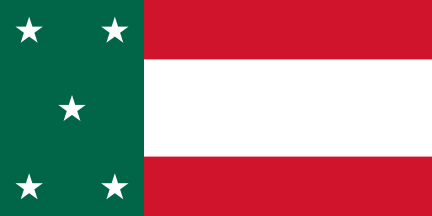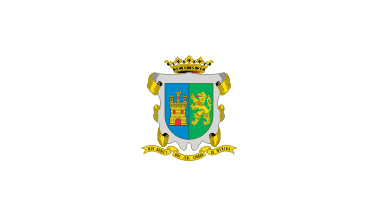

Last modified: 2009-05-03 by juan manuel gabino villascán
Keywords: mexico | yucatán | mérida | coat of arms | republic of yucatán | former arms | henequen plant | deer |
Links: FOTW homepage |
search |
disclaimer and copyright |
write us |
mirrors

|
4:7 |
| by Juan Manuel Gabino Villascán, May 06, 2001. | |
| See: Yucatan coat of arms of white bakground: unofficial flags |

|
1:2 |
| by Juan Manuel Gabino Villascán, May 06, 2001. | |
| See: Republic of Yucatán |
See:
See also:
INEGI and SEP
Reported by Juan Manuel Gabino Villascán, October 06, 2001.
.gif)
The description of the official coat of arms of Yucatán is as follows:
En campo de sinople, ciervo elanzado de oro, con sol moviente del mismo metal, surgiendo del ángulo siniestro del jefe. En punta: planta de henequén de oro, terrazada de piedras o lajas del mismo metal. Bordura de oro con dos arcos mayas y dos espadañas coloniales españolas, colocada en jefe y punta, diestra y siniestra, respectivamente.
Aproximadamente desde el siglo XV se inicia en España la costumbre de distinguir con emblemas heráldicos propios y particulares a las familias que ostentaban títulos de nobleza y a las ciudades principales, tradición que continuó en las posesiones españolas de todo el mundo. De esta suerte la ciudad de Mérida de Yucatán obtuvo el título de Muy Noble y Muy Leal –conferido en Valladolid (España) el 30 de abril de 1605 y confirmado por cédula real de 13 de julio de 1618-, y su escudo de armas que le otorgó el rey Felipe III en San Lorenzo el Real el 18 de agosto de 1618.
La Mérida mexicana, de hecho contó con doble escudo, pues el cabildo de 1543 asumió y confeccionó uno propio, que inútilmente propuso al rey confirmar, en el que figuraban cuatro torres y en medio una de homenaje, en cada torre una bandera verde y en la de homenaje un estandarte colorado en campo amarillo, armadas las torres sobre cuatro leones, las cabezas afuera, en memoria de la conquista y población de esta tierra. Estas armas –afirma el historiador Francisco Molina Solís– pervivieron en las banderas o insignias del ayuntamiento hasta 1821, sin mengua del escudo otorgado en la segunda decena del siglo XVII, que ostentaba un león ramparte en campo verde y un castillo torreado en campo azul.
Después de la independencia nacional, aceptada oficialmente por España en 1836, las flamantes entidades federativas mexicanas fueron reconocidas simbólicamente por los viejos escudos coloniales de sus ciudades capitales, cuyos nombres se adoptaron para designar a las nuevas demarcaciones geopolíticas en el sistema de Intendencia implantado en 1786. Así pues, desde este año hasta el de 1821 en que Yucatán se independizó de España –15 de septiembre-, la Intendencia de Mérida tuvo como escudo el de la ciudad de Mérida de Yucatán, que por extensión, costumbre o falta de interés público para renovarlo o adecuarlo, continuó usándose indebidamente como el del Estado de Yucatán hasta el presente año 1989 en que, por iniciativa del Lic. Víctor Manzanilla Schaffer, Gobernador Constitucional de Yucatán y con la aprobación del Congreso del Estado, se adoptó un Escudo de Armas bello y singular que pone fin a un período de algo más de ciento cincuenta años de ausencia heráldica oficial.
El 22 de septiembre de 1989, el C.Gobernador Constitucional del Estado, Lic. Víctor Manzanilla Schaffer, envió al Congreso local una iniciativa de decreto para adoptar un Escudo de Armas del Estado de Yucatán que lo representase oficialmente ante las demás entidades federativas de la República, ya que los gobiernos han utilizado casi en forma oficial el de la ciudad de Mérida, cometiendo una falta histórica que, en ocasiones, ha sido definida como usurpación heráldica.
Considerando el Ejecutivo del Estado que el carácter definitivo y perpetuo del conjunto simbólico debe ofrecer un mensaje intemporal y válido en cualquier tiempo presente y futuro y no quedar sujeto a ninguna confrontación ideológica de carácter histórico, político o religioso, propuso que en el escudo hubiera elementos representativos de los reinos naturales; un Henequén –verdadero milagro ecológico– afirmado sobre un suelo de lajas calcáreas, un Venado que es figura señera de nuestros montes, y un Sol implacable de rayos abrasadores como símbolo cósmico. El escudo de Yucatán también debe ostentar –dice la iniciativa– la presencia de las dos culturas básicas constitutivas de su pueblo: la maya y la española, representadas por elementos típicos de su arte arquitectónico, como son: el arco maya y la espadaña, remate inconfundible de los templos coloniales hispanos diseminados en la Península. Para dar sobriedad al moderno escudo se propuso el uso de dos esmaltes: el verde que es el color del campo y de la ecología, y el oro que es el esplendor de la tradicional riqueza cultural yucateca.
Los integrantes de las Comisiones Permanentes del Congreso, antes de entrar al estudio y análisis de la iniciativa del Gobernador del Estado, convocaron a la celebración de audiencias públicas para que todos los sectores de la población pudieran emitir criterios u opiniones que estimaran convenientes para la creación del escudo de armas, convocatoria a la respondieron tres personas con sendos proyectos, los que una vez ponderados por los Diputados de las comisiones aludidas, se decidieron por el trabajo que presentó el Sr. Juan Francisco Peón Ancona, y que correspondió a los planteamientos de la iniciativa del Ejecutivo del Estado. En tal virtud se emitió un proyecto de decreto que, una vez analizado y suscrito por LI Congreso Constitucional del Estado Libre y Soberano de Yucatán y refrendado por el C. Gobernador Constitucional del Estado Lic. Víctor Manzanilla Schaffer, fue promulgado [el 28 de noviembre de 1989] y publicado en el Diario Oficial del Gobierno del Estado de fecha 30 de noviembre de 1989.
By Lic. José Adonay Cetina Sierra, December, 1989,
in Dzidzantun.com
quoted by Juan Manuel Gabino Villascán, April, 2009.
The coat of arms of Yucatán was adopted on November 30, 1989, by Gobernor Víctor Manzanilla Schaffer.
Thogh the adoption of the new arms; in "Los Pinos", is still hoisted a white flag charged with the former arms.
Juan Manuel Gabino Villascán, May 06, 2001.
 4:7
4:7![]()
by Juan Manuel Gabino Villascán, January 13, 2005.
Like most of the Mexican states, Yucatán first used as arms those granted to its capital city, Mérida:
"A Spanish shield parted, the firts pale (left) azur charged by a castle in gold, and the second pale (right) a rampant lion in gold on sinople (green). The top is a royal crown. The ribbon bellow the shield bear the motto: "Muy noble y muy leal ciudad de Mérida".
Quoted by Juan Manuel Gabino Villascán, May 06, 2001.

|
1:2![[Non-official proportions]](../misc/_~~.gif) ![[Reconstruction]](../misc/oooooo.gif) ![[Reconstruction]](../misc/fis_reco.gif) ![[One or more variants under the same basic design]](../misc/fis_vari.gif)
|
| by Juan Manuel Gabino Villascán, May 06, 2001. |
"The most accurate version about the meaning of the five-star flag is that given by Historian Rodolfo Menéndez de la Peña, who wrote a brief introduction on the cover of the Serapio Baqueiro's book entitled 'Ensayo Histórico sobre las Revoluciones de Yucatán de 1840 a 1864' (Historic esay on the Yucatán revolutions from 1840 to 1864); the texts says: '...the Yucatán flag is divided into two fields: to the left, one field in green, and to the right, another divided in turn into three, red (top and bottom) and white (middle). The green area is featured by five beautiful stars standing for the five departments into wich Yucatán was administrativelly divided by Decree of November 30, 1840: Mérida, Izamal, Valladolid, Tekax and Campeche...' According the year on which the Peninsula was divided into five departments or districts, Writer José Antonio Adonay Cetina Sierra poits out another date in his work 'Apuntaciones para la Historia Legislativa del Municipio de Mérida' (Notes for the Legislative History of the Municipality of Mérida): 'It was then when Yucatán decreed on May 24, 1837 a new territorial division that reduced to five districts the then in effect colonial system; the town were distributed and in some cases the politic and administrative jurisdiction were enlarged: first district of Mérida, Department's capital; second district of Campeche; third district of Valladolid; fourth district of Izamal; and fifth district of Tekax' ".
"Respecting the Yucatanense flag it was displayed by a short time at the Palace of the Government, according to Mr. Espejo, we count with the following information supplied by Writer Juan Francisco Molina Solís in his work "History of Yucatán" vol. 1; page 177: 'On night of March 16, 1841, during a meeting for the installation fo the Mérida Constitutional Council, the main room was invaded by an unarmed crowd, led by Barbachano, Francisco Martín Peraza and some others, asking for the full independence of Yucatán; then the Council under the crowd's presure agreed to review the proposal, (...) some of the most exitated people clang to the Palace's roof and after downining the Mexican flag hoisted that of Yucatan.' (...)"
"After six months (?) (it should be say -seven months-) and four days when the flag of Yucatán appeared, then October 20, 1841, the Congress of Yucatán proclaimed the Independence of the Peninusula from the Centralist Mexican Government, and starts to use the Peninsula flag as its symbol before the world nations, flying it at the merchant and military ships, as soon as the public buildings until December 15, 1843, when the Yucatanense government signs a Peace and Friendship Agreement with the Mexican counterpart, stating in the article 15 the following:
'Article 15: Yucatán shall not use any flag but that of the nation (...)'...".
By: José Susano Durán Esquivel, "Las estrellas y la vigencia de la bandera de Yucatán"
in
160 aniversario de la Bandera de Yucatán
Quoted and translated by: Juan Manuel Gabino Villascán, July 21, 2001
This flag, one of several variants, is that used by the Republic of Yucatán
between March 16, 1841 (officially from October 20, 1841) and December 15, 1843.
Juan Manuel Gabino Villascán July 21, 2001.
The flag is divided in two fields. The hoist side bears, to my
rough calculations (could only get an artistic rendition and photos
with no regular sizes) a bit more than a third of the flag; this is a
green field, with five white five-pointed stars, arranged 2-1-2 (from top to bottom).
The fly is divided in three stripes: upper and lower in dark red,
and a central and wider one in white. Again, the proportions
might be worng, but that's more or less what the flag looks like.
Today, it is extensively used by the Yucatan public, seen on t-shirts,
stickers and bumperstickers, sport jackets and so on.
Guillermo Aveledo, August 19, 2000
I have had exactely the same problems. It appears that,
the flag of Yucatan is one of the most
popular unofficial flags of mexican states. I have visisted all web sites
refered here on this topic, and all show the same design with the wide
variation refered by Guillermo:
The overall ratio varies from ~2:3 to ~1:3 or longer; I'd settle for 1:2.
The shades are mostely bright, though one variation shows indeed the dark red shade used by Guillermo. I'd stick to medium red, though.
The stars are mostely five-pointed, though at least one flag variation shows six-pointed stars. Five pointed would be the adequate choice for a "typical" Yucatan flag.
The fly side stripes are almost always equal sized, but at least one flag variation shows 1+2+1 (spanish style). Again, equal sized stripes would be the adequate choice. The green area varies also a lot: I've seen it from smaller than 1/3rd to almost one half. What would be the average? 2/5ths, perhaps?
António Martins, September 23, 2000
At present it is seen everywhere as part of a tourist
campaign of the state
government.
Carlos Magaña Lara, December 13, 2000
Anything below this line was not added by the editor of this page.